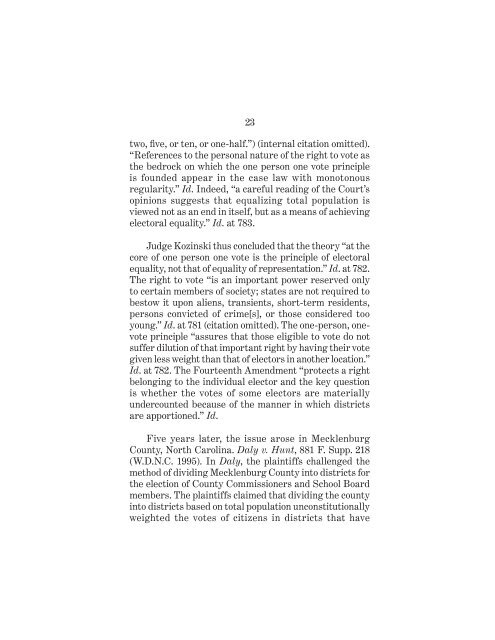petitioned the U.S. Supreme Court to grant ... - Election Law Blog
petitioned the U.S. Supreme Court to grant ... - Election Law Blog
petitioned the U.S. Supreme Court to grant ... - Election Law Blog
Create successful ePaper yourself
Turn your PDF publications into a flip-book with our unique Google optimized e-Paper software.
23two, five, or ten, or one-half.”) (internal citation omitted).“References <strong>to</strong> <strong>the</strong> personal nature of <strong>the</strong> right <strong>to</strong> vote as<strong>the</strong> bedrock on which <strong>the</strong> one person one vote principleis founded appear in <strong>the</strong> case law with mono<strong>to</strong>nousregularity.” Id. Indeed, “a careful reading of <strong>the</strong> <strong>Court</strong>’sopinions suggests that equalizing <strong>to</strong>tal population isviewed not as an end in itself, but as a means of achievingelec<strong>to</strong>ral equality.” Id. at 783.Judge Kozinski thus concluded that <strong>the</strong> <strong>the</strong>ory “at <strong>the</strong>core of one person one vote is <strong>the</strong> principle of elec<strong>to</strong>ralequality, not that of equality of representation.” Id. at 782.The right <strong>to</strong> vote “is an important power reserved only<strong>to</strong> certain members of society; states are not required <strong>to</strong>bes<strong>to</strong>w it upon aliens, transients, short-term residents,persons convicted of crime[s], or those considered <strong>to</strong>oyoung.” Id. at 781 (citation omitted). The one-person, onevoteprinciple “assures that those eligible <strong>to</strong> vote do notsuffer dilution of that important right by having <strong>the</strong>ir votegiven less weight than that of elec<strong>to</strong>rs in ano<strong>the</strong>r location.”Id. at 782. The Fourteenth Amendment “protects a rightbelonging <strong>to</strong> <strong>the</strong> individual elec<strong>to</strong>r and <strong>the</strong> key questionis whe<strong>the</strong>r <strong>the</strong> votes of some elec<strong>to</strong>rs are materiallyundercounted because of <strong>the</strong> manner in which districtsare apportioned.” Id.Five years later, <strong>the</strong> issue arose in MecklenburgCounty, North Carolina. Daly v. Hunt, 881 F. Supp. 218(W.D.N.C. 1995). In Daly, <strong>the</strong> plaintiffs challenged <strong>the</strong>method of dividing Mecklenburg County in<strong>to</strong> districts for<strong>the</strong> election of County Commissioners and School Boardmembers. The plaintiffs claimed that dividing <strong>the</strong> countyin<strong>to</strong> districts based on <strong>to</strong>tal population unconstitutionallyweighted <strong>the</strong> votes of citizens in districts that have








